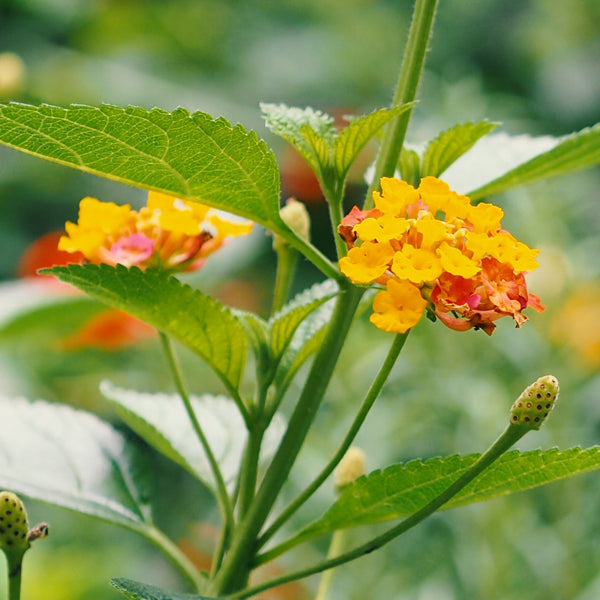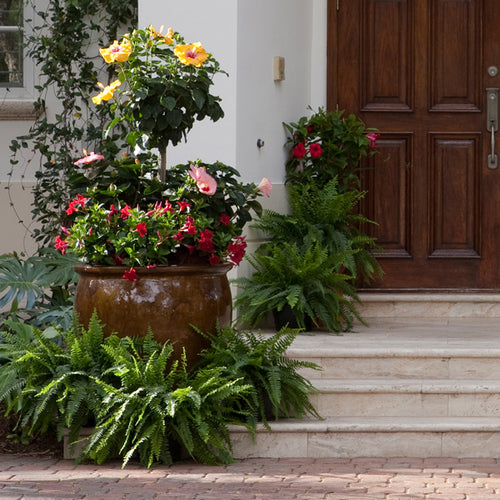
Annuals provide food for pollinators
Blooming nonstop from spring to fall, annual flowers are a reliable and consistent source of food for your insect neighbors.Here are ten butterfly favorites that you can grow in containers or in garden beds and borders.

Luscious Lantana
Perennial in frost free regions, lantana is a tough, drought-resistant annual that you can count on for summer-long color. These beauties come in a variety of colors including red, yellow, pink, white, orange, and multi colored. Lantana grows 15 to 24 inches tall and needs at least 6 to 8 hours of direct sunshine a day to thrive.Pollinator Perk: Because this over-achieving plant blooms right through the fall, it’s a top pick for butterflies such as Monarchs and Gulf Fritillary that migrate in the autumn.

Perky Pentas
Hot, midsummer temperatures won’t stop pentas from putting on a bold show of colorful flowers. In fact, the hotter it gets, the happier pentas seems to get. Each flower head holds clusters of individual star-shaped blooms in red, white, lavender, purple, or pink. The plants grow 12 to 24 inches tall, depending on variety.Pollinator Perk: Pentas is a butterfly magnet, attracting a wide range of species through the summer and fall.

Magnificent Marigold
Often called “America’s Favorite Flower” marigolds also rate highly with the winged wonders who flutter through your yard. Nectar-rich, marigold flowers are a cinch to grow and come in various shades of yellow, cream, burgundy, and white. Marigolds also come in two heights: dwarf and standard. Dwarf marigolds which grow 8 to 15 inches tall are ideal used as an edging or container plant. Standard types which can grow 24 to 36 inches high are perfect for the back of a flower border where they will create a wall of bloom behind your other annuals.Pollinator Perk: Plant both types of marigolds in your garden to create a pollinator buffet. Both are highly popular with honey bees and butterflies.

Zesty Zinnia
If you want to attract butterflies to your garden, be sure to include a generous selection of zinnias. These brilliant bloomers are treasured by a wide array of butterfly species that love to land on their broad flat flowers and suck deeply on the sweet nectar hidden between the petals. A native of Mexico, zinnias need hot, sunny weather to thrive. Like marigolds, zinnias come in a variety of shapes and sizes that vary from 8 inch tall dwarfs to 4 foot high giants.Pollinator Perk: Use short varieties for window boxes, baskets, and containers and grow taller varieties directly in the landscape. Taller zinnias also make great cut flowers.

Blue Salvia
One of our favorite annuals, blue salvia forms tall, willowy wands of soft blue or white flowers that attract a cadre of different butterfly species. Plus blue salvia never seems to slow down, showing off its color right up until hard frost. The plants grow 24 to 36 inches tall and look amazing when planted in large drifts or clumps or used to create a river of bloom weaving through beds of other annuals such as marigolds or pentas.Pollinator Perk: Butterflies like flowers growing in open, sunny spots. Like most annuals, blue salvia needs at least 6 to 8 hours of direct sunshine a day.

Sweet Alyssum
Color and fragrance! That’s what you’ll get,when you add sweet alyssum to your beds, borders, or containers. Sweet alyssum is cold tolerant which means you can set the plants into the garden earlier than most other annuals. Only a hard freeze will knock them back, but a light frost is not a problem. They may slow down a bit in mid-summer, but will start up again once cool fall weather sets in. Sweet alyssum grows 4 to 8 inches tall.Pollinator Perk: This low-growing beauty forms mounds of tiny white, blue, purple, or rose-color flowers, each one so loaded with nectar that butterflies will come calling as soon as you bring your plants home from the garden center.

Ageratum
Ideal for beds, borders, or containers, ageratum produces a never ending supply of small pom pom like flowers in shades of blue, white, purple, pink, lavender, or red. Ageratum is super easy to grow because it’s drought resistant and will tolerate partial shade. It’s also a favorite plant with honey bees who love to clamber through the fuzzy blooms harvesting pollen as they travel. Most ageratum varieties grow 6 to 12 inches tall, but some older types can reach 3 feet in height.Pollinator Perk: Keep plants blooming all summer by removing faded flowers as they appear.

Sunflower
The crowning glory of any flower bed, sunflowers will tower over other annuals, showcasing bold orange, yellow, chocolate, red, cream, or bi-colored blooms. Sizes vary by variety from 12 inches to 6 feet tall. Most produce broad, single flowers, but there are a few that develop petal packed balls of bloom. Bees and butterflies are attracted to sunflowers because the nectar is so readily accessible from the broad, open blooms. Taller types often bloom just once during the summer, make seeds, and die.Pollinator Perk: When selecting sunflowers look for those varieties that produce multiple flower flushes throughout the summer. That way, you can attract butterflies continuously throughout the summer.

Petunia
Here’s an annual that needs no introduction! That’s because petunias are popular everywhere you look. And there’s good reasons why they are so beloved. First, they come in a very wide array of flower shapes, forms and colors. Second, they thrive in containers as well as they do when planted directly in the landscape. Third, many varieties are surprisingly fragrant. Petunias grow 8 to 36 inches tall and require full sun.Pollinator Perk: Petunia flowers are laden with sweet food that butterflies, moths, and honey bees find irresistible.

















